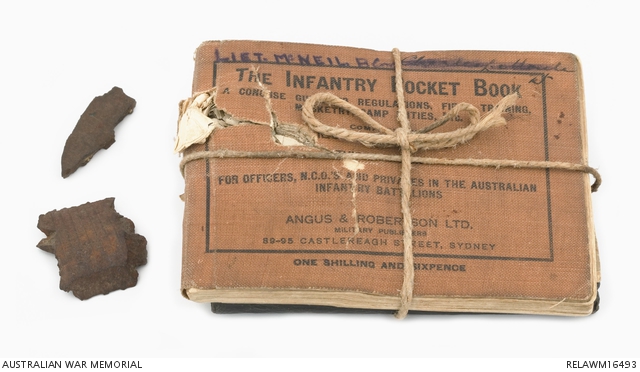| Place | Europe: France, Nord Pas de Calais, Pas de Calais, Bethune, Fleurbaix |
|---|---|
| Accession Number | RELAWM16493 |
| Collection type | Heraldry |
| Object type | Heraldry |
| Physical description | Elastic, Leatherette, Metal, Paper |
| Maker |
Angus & Robertson Unknown |
| Place made | Australia |
| Date made | c 1914-1916 |
| Conflict |
First World War, 1914-1918 |
Pieces of shrapnel and damaged notebooks : Lieutenant A W L MacNeil, 10 Battalion, AIF


Two pieces of shrapnel, a damaged Infantry Pocket Book, envelope and leatherette covered notebook tied together with a piece of string. The Infantry Pocket Book contains a nominal roll for 6 Platoon, 10 Battalion and written on the front cover is 'LIET. McNEIL B Coy'.
Born in Inverness, Scotland on 24 August 1892, Alexander W L MacNeil immigrated to Australia in 1912 and was employed as a boiler maker at the outbreak of the First World War. On 29 August 1914 he enlisted in the AIF as a private with 10th Infantry Battalion at Morphettville, South Australia and received the regimental number 746. In October MacNeil sailed for Egypt and spent some months training in Cairo before embarking for Turkey where his battalion formed part of the covering force for the ANZAC landing on 25 April 1915. 10th Battalion were amongst the first ashore at around 4.30 am and were heavily involved in establishing and defending the front line of the ANZAC position. MacNeil served throughout the Gallipoli campaign during which he was promoted to sergeant on 19 August. After the withdrawal from Gallipoli in December 10 Battalion returned to Egypt.
In March 1916 MacNeil sailed for France and the Western Front where he was promoted to lieutenant. In mid June he was hit by shrapnel during action at Fleurbaix. Luckily, MacNeil was carrying these notebooks in his right breast pocket at the time. Medical Officers treating his wounds believed that they saved his life by taking the full impact of the blow and preventing the shrapnel from tearing his lung by deflecting it downward into his abdomen at a slightly less dangerous angle. The pieces of shrapnel were extracted from MacNeil's abdomen and given to him as a souvenir. After recovering from his wounds MacNeil was transferred to 3 Australian Light Trench Mortar Battery in January 1917. On May 6 he was involved in heavy fighting on the Hindenburg Line east of Bullecourt, France. While originally recommended for the Victoria Cross for his brave actions in defending the Australian line against German bombing attacks, he was ultimately awarded the Distinguished Service Order. MacNeil later went on to train at the Southern Command Bombing School, Lyndhurst and qualified as an instructor in November. Returning to his original unit, 10 Battalion, MacNeil was discharged on 3 February 1919 though he remained in Britain for some years before returning to Australia in 1922.
Share this page
Related information
Conflicts
Events
Related Objects
- A garland trench mortar in a post on Silt Spur at Anzac, occupied by the 10th Battalion. ...
- Waterproof carrier envelope and maps : Lieutenant A W L MacNeil, 3 Light Trench Mortar Battery, AIF
- Distinguished Service Order : Lieutenant A W L MacNeil, 3 Light Trench Mortar Battery, AIF
- 1914-15 Star : Lance Corporal A W L MacNeil, 10 Battalion, AIF
- British War Medal 1914-20 : Lieutenant A W L MacNeil, 3 Light Trench Mortar Battery, AIF
- Victory Medal with MID : Lieutenant A W L MacNeil, 3 Light Trench Mortar Battery, AIF